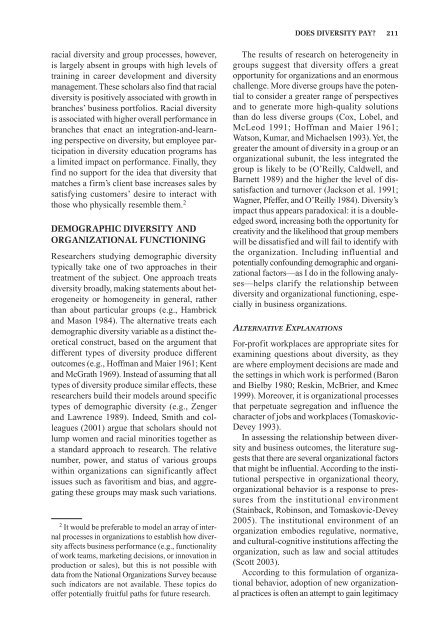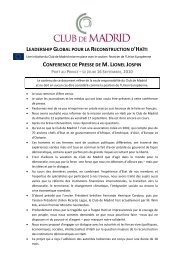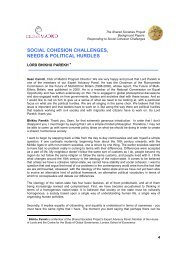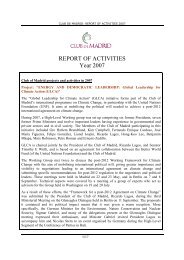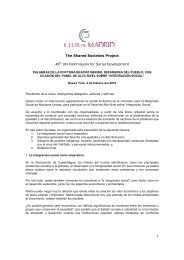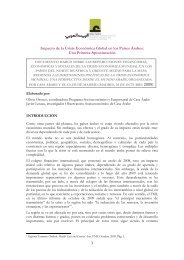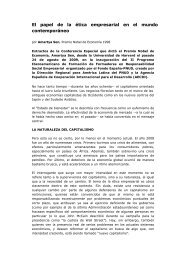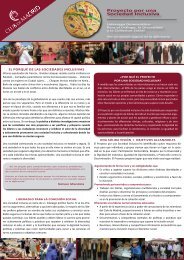Does Diversity Pay? - American Sociological Association
Does Diversity Pay? - American Sociological Association
Does Diversity Pay? - American Sociological Association
Create successful ePaper yourself
Turn your PDF publications into a flip-book with our unique Google optimized e-Paper software.
DOES DIVERSITY PAY?—–211<br />
racial diversity and group processes, however,<br />
is largely absent in groups with high levels of<br />
training in career development and diversity<br />
management. These scholars also find that racial<br />
diversity is positively associated with growth in<br />
branches’ business portfolios. Racial diversity<br />
is associated with higher overall performance in<br />
branches that enact an integration-and-learning<br />
perspective on diversity, but employee participation<br />
in diversity education programs has<br />
a limited impact on performance. Finally, they<br />
find no support for the idea that diversity that<br />
matches a firm’s client base increases sales by<br />
satisfying customers’ desire to interact with<br />
those who physically resemble them. 2<br />
DEMOGRAPHIC DIVERSITY AND<br />
ORGANIZATIONAL FUNCTIONING<br />
Researchers studying demographic diversity<br />
typically take one of two approaches in their<br />
treatment of the subject. One approach treats<br />
diversity broadly, making statements about heterogeneity<br />
or homogeneity in general, rather<br />
than about particular groups (e.g., Hambrick<br />
and Mason 1984). The alternative treats each<br />
demographic diversity variable as a distinct theoretical<br />
construct, based on the argument that<br />
different types of diversity produce different<br />
outcomes (e.g., Hoffman and Maier 1961; Kent<br />
and McGrath 1969). Instead of assuming that all<br />
types of diversity produce similar effects, these<br />
researchers build their models around specific<br />
types of demographic diversity (e.g., Zenger<br />
and Lawrence 1989). Indeed, Smith and colleagues<br />
(2001) argue that scholars should not<br />
lump women and racial minorities together as<br />
a standard approach to research. The relative<br />
number, power, and status of various groups<br />
within organizations can significantly affect<br />
issues such as favoritism and bias, and aggregating<br />
these groups may mask such variations.<br />
2 It would be preferable to model an array of internal<br />
processes in organizations to establish how diversity<br />
affects business performance (e.g., functionality<br />
of work teams, marketing decisions, or innovation in<br />
production or sales), but this is not possible with<br />
data from the National Organizations Survey because<br />
such indicators are not available. These topics do<br />
offer potentially fruitful paths for future research.<br />
The results of research on heterogeneity in<br />
groups suggest that diversity offers a great<br />
opportunity for organizations and an enormous<br />
challenge. More diverse groups have the potential<br />
to consider a greater range of perspectives<br />
and to generate more high-quality solutions<br />
than do less diverse groups (Cox, Lobel, and<br />
McLeod 1991; Hoffman and Maier 1961;<br />
Watson, Kumar, and Michaelsen 1993). Yet, the<br />
greater the amount of diversity in a group or an<br />
organizational subunit, the less integrated the<br />
group is likely to be (O’Reilly, Caldwell, and<br />
Barnett 1989) and the higher the level of dissatisfaction<br />
and turnover (Jackson et al. 1991;<br />
Wagner, Pfeffer, and O’Reilly 1984). <strong>Diversity</strong>’s<br />
impact thus appears paradoxical: it is a doubleedged<br />
sword, increasing both the opportunity for<br />
creativity and the likelihood that group members<br />
will be dissatisfied and will fail to identify with<br />
the organization. Including influential and<br />
potentially confounding demographic and organizational<br />
factors—as I do in the following analyses—helps<br />
clarify the relationship between<br />
diversity and organizational functioning, especially<br />
in business organizations.<br />
ALTERNATIVE EXPLANATIONS<br />
For-profit workplaces are appropriate sites for<br />
examining questions about diversity, as they<br />
are where employment decisions are made and<br />
the settings in which work is performed (Baron<br />
and Bielby 1980; Reskin, McBrier, and Kmec<br />
1999). Moreover, it is organizational processes<br />
that perpetuate segregation and influence the<br />
character of jobs and workplaces (Tomaskovic-<br />
Devey 1993).<br />
In assessing the relationship between diversity<br />
and business outcomes, the literature suggests<br />
that there are several organizational factors<br />
that might be influential. According to the institutional<br />
perspective in organizational theory,<br />
organizational behavior is a response to pressures<br />
from the institutional environment<br />
(Stainback, Robinson, and Tomaskovic-Devey<br />
2005). The institutional environment of an<br />
organization embodies regulative, normative,<br />
and cultural-cognitive institutions affecting the<br />
organization, such as law and social attitudes<br />
(Scott 2003).<br />
According to this formulation of organizational<br />
behavior, adoption of new organizational<br />
practices is often an attempt to gain legitimacy


